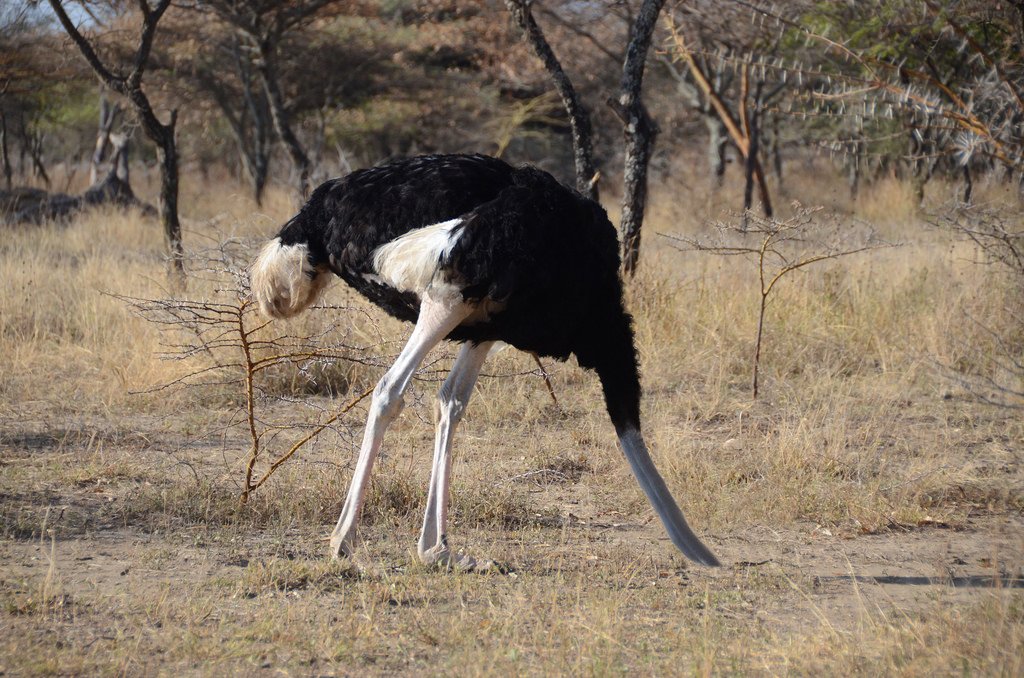In popular culture, the idea has been established that in case of danger, ostriches behave very strangely. We figured out how true this idea is.
Ostriches are unusual birds, so it is not surprising that their behavior can be unusual. The Internet is full of drawings and photographs of ostriches in an indecent pose - head down, back up. The same behavior of ostriches can be observed in the popular Soviet cartoon "Wings, Legs and Tails" and American animated series Jungle Cubs based on Kipling's The Jungle Book.
In Russian and many other languages, it gave rise to the phraseology “hiding your head in the sand,” which is used to address cowardly and indecisive people. More Dostoevsky in the 1846 story “The Double” wrote: “He burned with shame and buried his victorious head in the paper, for exactly the same purpose with which an ostrich, pursued by a hunter, hides its head in the hot sand.” The Russian-language Wikipedia says: “The common belief that ostriches bury their heads in the sand to escape predators originates in the works of the Roman thinker Pliny the Elder, in whose notes we read: “Ostriches imagine that when they stick their head and neck into the ground, their whole body seems hidden.”
In Natural History, Pliny the Elder actually talks about the mental abilities of ostriches: “Their stupidity is no less remarkable; although their body is large, they imagine that by sticking their head and neck into the bushes they will make their whole body invisible.” Most likely, the author of the article in Wikipedia made a mistake when translating and wrote “earth” instead of “bushes”, and the authors of other publications, for example in "Arguments and facts", did not double-check the quote English translation. However, in the stable expression it is sand that is mentioned. So it is unlikely that only a quotation from Pliny can explain the emergence of a stereotype.
Ostriches are indeed very awkward in appearance, disproportionate and cannot fly. At the same time, birds are able to turn their own shortcomings into advantages - for example, a long neck and large eyes allow them to notice an approaching predator at a great distance, from which they can escape thanks to equally long legs. If the ability to reach speeds of up to 65 km/h is not enough and you have to defend yourself, the huge sharp claws on your paws can come into play.
It turns out that the ostrich has an impressive arsenal for self-defense. Why, then, should the bird hide its head in the ground and hope that it will not be noticed? Moreover, it is quite difficult not to notice an ostrich. However, one of the main enemies of these birds is cheetahs, which are faster than ostriches. If they encounter them, ostriches sometimes try to disguise themselves, but they still don’t hide their heads in the sand:
There are several explanations why such a stereotype appeared in culture. Experts from the San Diego Zoo claim that this is precisely due to one of the camouflage tactics in case of a possible attack. The ostrich descends to the ground and stretches out its neck and head on it, and due to the similarity of the coloring with the color of the sand, an optical illusion is created. Scientist Karl Krushelnicki believesthat the myth arose due to the behavioral feature of ostriches: for better digestion, they eat gravel and small pebbles.
Charlotte Corney, BBC science journalist leads another explanation. Ostriches lay their eggs in specially dug burrows and sometimes stick their heads inside to rotate the eggs to distribute temperature evenly. This is an opinion divides and Steven Lovgren. In the material for National Geographic The journalist also draws attention to the fact that sometimes ostriches simply lower their heads very low to check whether a predator is hiding in the bushes or grass. You can make sure by watching a cute video about how an ostrich leads its family to a watering hole, first checking to see if there is any danger around:
Fake
Read on topic:
- http://www.abc.net.au/science/articles/2006/11/02/1777947.htm
- https://animals.sandiegozoo.org/animals/ostrich
- https://kids.nationalgeographic.com/explore/nature/animal-myths-busted/
If you find a spelling or grammatical error, please let us know by highlighting the error text and clicking Ctrl+Enter.







